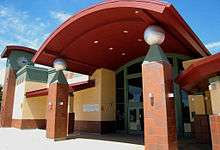San Jose Unified School District
San José Unified School District (abbreviated SJUSD) is a TK-12 unified school district in Santa Clara County, California, that covers a large portion of the city of San Jose. The district has more than 3,000 full-time employees serving approximately 30,000 students in 41 schools from Downtown San Jose in the north to the Almaden Valley in the south. It is one of 19 school districts that serve parts of San Jose, the largest school district in the Santa Clara Valley, and the 24th largest in California.[3][4][5]
| San José Unified School District | |
|---|---|
 | |
| Location | |
| San Jose, California Santa Clara County United States | |
| Coordinates | 37°20′10″N 121°54′41″W |
| District information | |
| Type | Unified school district |
| Grades | TK–12 |
| Established | 1853 |
| Superintendent | Nancy Albarrán |
| Schools | 41 |
| NCES District ID | 0634590[1] |
| Students and staff | |
| Students | 31,713[2] |
| Teachers | 1,412.15 FTE[1] |
| Staff | Over 3,000 |
| Other information | |
| Website | web |
Mission and vision
San José Unified's vision is "Preparing today’s students to be the thinkers, leaders, and creators of tomorrow." The district's mission is "Uniting as one community, we elevate opportunities for all."[6]
History
San José Unified School District was established in 1853 as the San Jose City School District. The district adopted its present name in 1936.
In 1863, the district opened San Jose High School, the second-oldest public high school in California. In 1953, the district took over operation of San Jose City College from San Jose State College.
State law originally required school districts to be coterminous with city limits. San Jose's rapid expansion under city manager Dutch Hamann caused territory to be transferred to the San José Unified School District from the surrounding rural school districts. The rural districts used lawsuits to delay or block annexations in an attempt to preserve their tax bases. In 1954, the state passed a law allowing school districts to have distinct boundaries from cities, mostly confining San José Unified School District to its boundaries at the time. Christensen (2015) cites the resulting hodgepodge of school districts within San Jose as a contributing factor in the city's "fragmented politics, lack of identity and racial segregation".[3] The law also required certain elementary districts to either build their own high school or be annexed by a district that already had a high school. Thus, in 1956, the voters in Almaden Union School District elected to merge with San José Unified.[7]
In 1971, parents in San Jose filed suit against the school district to force school integration. The district claimed that any racial segregation was due to housing patterns, not explicit policy. However, in 1984, the United States District Court for the Northern District of California issued a desegregation order for the school district, embarrassing local officials.[8] The district responded by opening magnet schools and busing students.[9]
In 1983, federal bankruptcy judge Seymour Abrahams declared the school board bankrupt under Chapter 9. The judge rolled back employee wages.[10]
In the late 1990s, a fire sprinkler broke in the basement of the district office, destroying many of the district's historic documents. District staff and local historians have been working ever since to rebuild the district archive.
By 2017, a high cost of living and housing shortage had contributed to the district's declining enrollment.[11]
Over 164 years, San José Unified has supported 53 elementary schools, of which 26 remain active as of the 2017–2018 school year. Additionally, the district supports six comprehensive middle schools, six comprehensive high schools, a continuation high school, and an alternative education school.[12]



List of schools
| School Name | Students | FTE Teachers | Pupil/Teacher Ratio |
|---|---|---|---|
| Allen at Steinbeck (K-8) | 807 | 47 | 17.2 |
| Almaden Elementary School | 415 | 25 | 16.6 |
| Bachrodt Elementary School | 644 | 39 | 16.5 |
| Booksin Elementary School | 794 | 36 | 22.1 |
| Broadway High School | 251 | 18 | 13.9 |
| Canoas Elementary School | 429 | 27 | 17 |
| Rachel Carson Elementary School | 422 | 21 | 20.1 |
| Castillero Middle School | 1247 | 61 | 20.4 |
| Anne Darling Elementary School | 473 | 34 | 13.9 |
| Downtown College Prep | 399 | 25 | 16 |
| Empire Gardens Elementary School | 450 | 19 | 23.7 |
| Gardner Elementary School | 549 | 27 | 20.3 |
| Grant Elementary School | 602 | 28 | 21.5 |
| Graystone Elementary School | 758 | 36 | 21.1 |
| Gunderson High School | 1128 | 57 | 19.8 |
| Hacienda Environmental Science Magnet School | 688 | 32 | 21.5 |
| Hammer Montessori Magnet School | 312 | 14 | 22.3 |
| Bret Harte Middle School | 1999 | 56 | 21.3 |
| Herbert Hoover Middle School | 1093 | 63 | 17.3 |
| Leland High School | 1795 | 82 | 21.9 |
| Liberty High School | 334 | 26 | 12.8 |
| Abraham Lincoln High School | 1786 | 84 | 21.2 |
| Los Alamitos Elementary School | 703 | 31 | 22.7 |
| Lowell Elementary School | 399 | 25 | 17.1 |
| Horace Mann Elementary School | 614 | 32 | 16 |
| Middle College High School | 42 | 2 | 21 |
| John Muir Middle School | 1178 | 54 | 21.8 |
| Muwekma Ohlone Middle School | 883 | 51 | 20.2 |
| Olinder Elementary School | 443 | 32 | 13.8 |
| Pioneer High School | 1627 | 77 | 21.1 |
| Reed Elementary School | 513 | 23 | 22.3 |
| River Glen Elementary School | 538 | 26 | 20.7 |
| San Jose Community High School | 15 | 5 | 3 |
| San Jose High School | 1119 | 58 | 19.3 |
| Schallenberger Elementary School | 564 | 25 | 22.7 |
| Simonds Elementary School | 719 | 31 | 23.2 |
| Terrell Elementary School | 529 | 29 | 18.2 |
| Trace Elementary School | 1002 | 51 | 19.4 |
| Washington Elementary School | 507 | 34 | 14.9 |
| Williams Elementary School | 718 | 28 | 25.6 |
| Willow Glen Elementary School | 749 | 33 | 22.7 |
| Willow Glen High School | 1589 | 77 | 20.6 |
| Willow Glen Middle School | 1227 | 73 | 16.8 |
* Note: Based on data from the 2013-2014 school year
References
- "Search for Public School Districts – District Detail for San Jose Unified". National Center for Education Statistics. Institute of Education Sciences. Retrieved February 27, 2019.
- "K-12 Public School Enrollment: 4369666-San Jose Unified". DataQuest. California Department of Education. Retrieved February 27, 2019.
- Christensen 2015, p. 11.
- Keller, Matt (August 15, 2018). "Students in largest Silicon Valley school district go back to class". KGO-TV. Retrieved February 27, 2019.
- "Vote Meek, Foley for San Jose Unified board". The Mercury News. DigitalFirst Media. October 28, 2016. Retrieved February 27, 2019.
- https://web.sjusd.org/who-we-are/our-story/
- San Jose Mercury News. January 18, 1956. Missing or empty
|title=(help) - Vasquez et al. v. San Jose Unified School District, 633 F. Supp. 808 (N.D. Cal. 1986).
- Christensen 2015, p. 18.
- "San Jose Schools Can Cut Pay, U.S. Bankruptcy Court Rules". The New York Times. August 30, 1983. p. B8.
- Sanchez, Kris (September 13, 2017). "San Jose Unified School District Enrollment to Plunge Amid Skyrocketing Living Costs, Shortage of Single-Family Homes". KNTV. Retrieved February 27, 2019.
- "Find your school | Schools | Our Schools | San José Unified School District".
Further reading
- Christensen, Terry (October 5, 2015). Flashback: a short political history of San Jose (PDF). Retrieved February 26, 2019.CS1 maint: ref=harv (link) Excerpted from Trounstine, Philip J.; Christensen, Terry (1982). Movers and Shakers: The Study of Community Power. New York City: St. Martin's Press. ISBN 9780312549633.
External links
| Wikimedia Commons has media related to San Jose Unified School District. |
